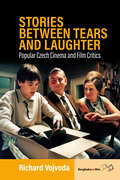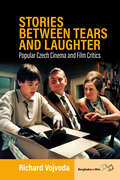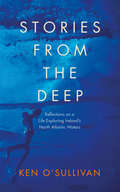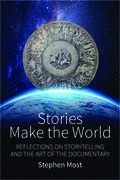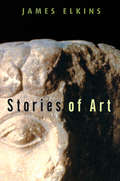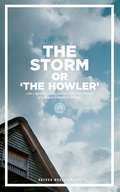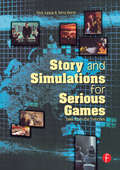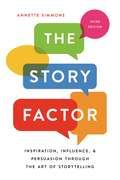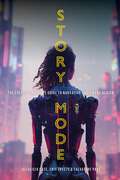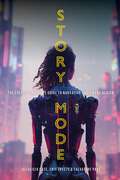- Table View
- List View
Stories between Tears and Laughter: Popular Czech Cinema and Film Critics
by Richard VojvodaWhile histories of Czech cinema often highlight the quality of Czechoslovak New Wave films made in the 1960s, post-socialist Czech cinema receives little attention. Through a methodology of historical reception, Stories between Tears and Laughter explores how attitudes towards post-socialist Czech cinema have shifted from viewing it as radical “art cinema” and more towards popular cinema. By analyzing publicity materials, reviews, and articles, Richard Vojvoda offers a new perspective on the notions of cultural value and quality that have been shaping the history of post-socialist Czech cinema.
Stories between Tears and Laughter: Popular Czech Cinema and Film Critics
by Richard VojvodaWhile histories of Czech cinema often highlight the quality of Czechoslovak New Wave films made in the 1960s, post-socialist Czech cinema receives little attention. Through a methodology of historical reception, Stories between Tears and Laughter explores how attitudes towards post-socialist Czech cinema have shifted from viewing it as radical “art cinema” and more towards popular cinema. By analyzing publicity materials, reviews, and articles, Richard Vojvoda offers a new perspective on the notions of cultural value and quality that have been shaping the history of post-socialist Czech cinema.
Stories from the Deep: Reflections on a Life Exploring Ireland's North Atlantic Waters
by Ken O'SullivanSpun from the author’s first-hand experience as an underwater cameraman and filmmaker, from memory, natural history and the culture of Ireland’s coastal communities, Stories from the Deep is a profound exploration of Ireland’s ocean waters through narrative and poetry.From encounters with its rarest and most striking fauna, like the blue whale and basking shark, to the broader considerations of its impact on language and our shared sense of place, this genre-defying work is an eloquent and urgent tribute to the enduring beauty of our natural heritage and a moving elegy to our magical connection with the sea.
Stories in Stone: The Enchanted Gem Carvings of Vasily Konovalenko
by Stephen E. NashVasily Konovalenko’s unique, dynamic, and theatrical sculptures stand alone in the gem-carving world—bawdy but not salacious, political but not diplomatic, boisterous and exuberant yet occasionally sensitive. Stories in Stone offers the first comprehensive treatment of the life of this little-known Russian artist and the remarkable history of his wonderful sculptures. Part art catalogue and part life history, Stories in Stone tells the tale of Konovalenko’s impressive works, explaining their conception, creation, and symbolism. Each handcrafted figure depicts a scene from life in the Soviet Union—a bowman hunting snow geese, a woman reposing in a hot spring surrounded by ice, peasants spinning wool, a pair of gulag prisoners sawing lumber—painstakingly rendered in precious stones and metals. The materials used to make the figurines are worth millions of dollars, but as cultural artifacts, the sculptures are priceless. Author Stephen Nash draws upon oral history and archival research to detail the life of their creator, revealing a rags-to-riches and life-imitates-art narrative full of Cold War intrigue, Communist persecution, and capitalist exploitation. Augmented by Richard M. Wicker’s exquisite and revelatory photographs of sixty-five Konovalenko sculptures from museums, state agencies, and private collections around the world, Stories in Stone is a visually stunning glimpse into a unique corner of Russian art and cultural history, the craft and science of gem carving, and the life of a Russian artist and immigrant who loved people everywhere. Co-published with the Denver Museum of Nature & Science, home to the most significant collection of Russian gem-carving sculptures by Vasily Konovalenko in the world.
Stories Make the World: Reflections on Storytelling and the Art of the Documentary
by Stephen MostSince the beginning of human history, stories have helped people make sense of their lives and their world. Today, an understanding of storytelling is invaluable as we seek to orient ourselves within a flood of raw information and an unprecedented variety of supposedly true accounts. In Stories Make the World, award-winning screenwriter Stephen Most offers a captivating, refreshingly heartfelt exploration of how documentary filmmakers and other storytellers come to understand their subjects and cast light on the world through their art. Drawing on the author’s decades of experience behind the scenes of television and film documentaries, this is an indispensable account of the principles and paradoxes that attend the quest to represent reality truthfully.
Stories of Art
by James ElkinsStories of Art is James Elkins's intimate history of art. Concise and original, this engaging book is an antidote to the behemoth art history textbooks from which we were all taught. As he demonstrates so persuasively, there can never be one story of art. Cultures have their own stories - about themselves, about other cultures - and to hear them all is one way to hear the multiple stories that art tells. But each of us also has our own story of art, a kind of private art history made up of the pieces we have seen, and loved or hated, the effects they had on us, and the connections that might be drawn among them. Elkins opens up the questions that traditional art history usually avoids. What about all the art not produced in Western Europe or in the Europeanized Americas? Is it possible to include Asian art and Indian art in ‘the story?’ What happens when one does? To help us find answers, he uses both Western and non-Western artworks, tables of contents from art histories written in cultures outside the centre of Western European tradition, and strangely wonderful diagrams of how artworks might connect through a single individual. True multiculturalism may be an impossibility, but art lovers can each create a ‘story of art’ that is right for themselves.
Stories of Art
by James ElkinsStories of Art is James Elkins's intimate history of art. Concise and original, this engaging book is an antidote to the behemoth art history textbooks from which we were all taught. As he demonstrates so persuasively, there can never be one story of art. Cultures have their own stories - about themselves, about other cultures - and to hear them all is one way to hear the multiple stories that art tells. But each of us also has our own story of art, a kind of private art history made up of the pieces we have seen, and loved or hated, the effects they had on us, and the connections that might be drawn among them. Elkins opens up the questions that traditional art history usually avoids. What about all the art not produced in Western Europe or in the Europeanized Americas? Is it possible to include Asian art and Indian art in ‘the story?’ What happens when one does? To help us find answers, he uses both Western and non-Western artworks, tables of contents from art histories written in cultures outside the centre of Western European tradition, and strangely wonderful diagrams of how artworks might connect through a single individual. True multiculturalism may be an impossibility, but art lovers can each create a ‘story of art’ that is right for themselves.
Stories of Cosmopolitan Belonging: Emotion and Location
by Hannah Jones Emma JacksonWhat does it mean to belong in a place, or more than one place? This exciting new volume brings together work from cutting-edge interdisciplinary scholars researching home, migration and belonging, using their original research to argue for greater attention to how feeling and emotion is deeply embedded in social structures and power relations. Stories of Cosmopolitan Belonging argues for a practical cosmopolitanism that recognises relations of power and struggle, and that struggles over place are often played out through emotional attachment. Taking the reader on a journey through research encounters spiralling out from the global city of London, through English suburbs and European cities to homes and lives in Jamaica, Puerto Rico and Mexico, the contributors show ways in which international and intercontinental migrations and connections criss-cross and constitute local places in each of their case studies. With a reflection on the practice of 'writing cities' from two leading urbanists and a focus throughout the volume on empirical work driving theoretical elaboration, this book will be essential reading for those interested in the politics of social science method, transnational urbanism, affective practices and new perspectives on power relations in neoliberal times. The international range of linked case studies presented here will be a valuable resource for students and scholars in sociology, anthropology, urban studies, cultural studies and contemporary history, and for urban policy makers interested in innovative perspectives on social relations and urban form.
Stories of Cosmopolitan Belonging: Emotion and Location
by Hannah Jones Emma JacksonWhat does it mean to belong in a place, or more than one place? This exciting new volume brings together work from cutting-edge interdisciplinary scholars researching home, migration and belonging, using their original research to argue for greater attention to how feeling and emotion is deeply embedded in social structures and power relations. Stories of Cosmopolitan Belonging argues for a practical cosmopolitanism that recognises relations of power and struggle, and that struggles over place are often played out through emotional attachment. Taking the reader on a journey through research encounters spiralling out from the global city of London, through English suburbs and European cities to homes and lives in Jamaica, Puerto Rico and Mexico, the contributors show ways in which international and intercontinental migrations and connections criss-cross and constitute local places in each of their case studies. With a reflection on the practice of 'writing cities' from two leading urbanists and a focus throughout the volume on empirical work driving theoretical elaboration, this book will be essential reading for those interested in the politics of social science method, transnational urbanism, affective practices and new perspectives on power relations in neoliberal times. The international range of linked case studies presented here will be a valuable resource for students and scholars in sociology, anthropology, urban studies, cultural studies and contemporary history, and for urban policy makers interested in innovative perspectives on social relations and urban form.
Stories of Fashion, Textiles, and Place: Evolving Sustainable Supply Chains
by Leslie Davis Burns Jeanne CarverStories of Fashion, Textiles, and Place follows the journeys of five companies with evolving sustainable supply chains in the fashion and textile industry. Each of the profiled companies are committed to advancing cultural traditions of a particular place. They value, honor, and are all deeply rooted in the geography, culture, and people of a specific location and their success is attributable to their connection to that place. With this shared value, their unique stories highlight the conditions, risks, strategies, and successes in creating and maintaining sustainable supply chains for ready-to-wear and home fashions. The companies include:-Imperial Stock Ranch and Shaniko Wool Company – Oregon, USA-Angela Damman Yucatán – Yucatán, Mexico-Tonlé – Phenom Penh, Cambodia-Indigenous Designs – Highlands, Peru-Harris Tweed® – Outer Hebrides, Scotland, UKWith a focus on economic, social, environmental, and cultural sustainability, and the connection between textiles and place, Burns and Carver offer personal and insightful narratives of companies addressing the challenges facing today's global fashion industry.
Stories of Fashion, Textiles, and Place: Evolving Sustainable Supply Chains
by Leslie Davis Burns Jeanne CarverStories of Fashion, Textiles, and Place follows the journeys of five companies with evolving sustainable supply chains in the fashion and textile industry. Each of the profiled companies are committed to advancing cultural traditions of a particular place. They value, honor, and are all deeply rooted in the geography, culture, and people of a specific location and their success is attributable to their connection to that place. With this shared value, their unique stories highlight the conditions, risks, strategies, and successes in creating and maintaining sustainable supply chains for ready-to-wear and home fashions. The companies include:-Imperial Stock Ranch and Shaniko Wool Company – Oregon, USA-Angela Damman Yucatán – Yucatán, Mexico-Tonlé – Phenom Penh, Cambodia-Indigenous Designs – Highlands, Peru-Harris Tweed® – Outer Hebrides, Scotland, UKWith a focus on economic, social, environmental, and cultural sustainability, and the connection between textiles and place, Burns and Carver offer personal and insightful narratives of companies addressing the challenges facing today's global fashion industry.
The Storm Or, the Howler (Oberon Modern Plays)
by Peter OswaldDescending from the heavenly sphere of the gods to the mortal world below, Arcturus raises a mighty storm. For Labrax, a ‘procurer’ of women, the storm brings shipwreck and ruin. For his two female captives it offers a chance of escape. Washed up on a rocky coastline the two women seek refuge in the shrine of Venus, but it seems that the goddess alone cannot protect them. They are forced to rely instead on the help of the elderly Daemones, who is already struggling to control his reluctant slaves: the impudent Sceparnio and the inept Gripus.Drawn from a lost Greek play, The Storm is the most popular of Plautus’ Roman comedies. This version opened at Shakespeare’s Globe Theatre in July 2005 as part of the ‘World and Underworld’ Season.
Story and Simulations for Serious Games: Tales from the Trenches
by Nick Iuppa Terry BorstHow to create a simulation where participants have a sense of freedom and personal control while still maintaining the structure necessary for an effective story is a difficult task indeed. This book examines how to create an engaging, effective story (necessary to teach participants), while relating practical considerations of building a simulation. It also looks at stories as classic ways of teaching and gathering knowledge and considers other theories of interactive narrative design such as synthetic story creation and management and participant-generated story experiences. It also discusses enabling technologies in artificial intelligence, synthetic characters design and development, speech recognition technology, 3D modelling, and the future of story-driven games. Story Driven Simulations reviews the existing efforts in this field as well as focusing on the recent efforts of Paramount Pictures and The Institute for Creative Technologies at the University of Southern California, where this expert author team created successful simulations for the U.S. Army, Department of Defense, as well as other educational simulations.
Story and Simulations for Serious Games: Tales from the Trenches
by Nick Iuppa Terry BorstHow to create a simulation where participants have a sense of freedom and personal control while still maintaining the structure necessary for an effective story is a difficult task indeed. This book examines how to create an engaging, effective story (necessary to teach participants), while relating practical considerations of building a simulation. It also looks at stories as classic ways of teaching and gathering knowledge and considers other theories of interactive narrative design such as synthetic story creation and management and participant-generated story experiences. It also discusses enabling technologies in artificial intelligence, synthetic characters design and development, speech recognition technology, 3D modelling, and the future of story-driven games. Story Driven Simulations reviews the existing efforts in this field as well as focusing on the recent efforts of Paramount Pictures and The Institute for Creative Technologies at the University of Southern California, where this expert author team created successful simulations for the U.S. Army, Department of Defense, as well as other educational simulations.
The Story Factor: Inspiration, Influence, and Persuasion through the Art of Storytelling
by Annette SimmonsFully revised, updated, and expanded, this modern classic will teach you to use the art of storytelling to persuade, motivate, and inspire in life and business Anyone seeking to influence others must first know their own story, and how to tell it properly. Whether you're proposing a risky new venture, trying to close a deal, or leading a charge against injustice, you have a story to tell. Tell it well and you will create a shared experience with your listeners that can have profound results.In this modern classic, Annette Simmons reminds us that the oldest tool of influence is also the most powerful. Fully revised and updated to account for new technology and social media, along with two new chapters on the role of stories in the development of civilization and how to adjust your story to your specific goal, Simmons showcases over a hundred examples of effective storytelling drawn from the front lines of business and government, as well as myths, fables, and parables from around the world. Whether writing a screenplay, or announcing a corporate reorganization, Simmons illustrates how story can be used in ways that cold facts, bullet points, and directives can't. These stories, combined with practical storytelling techniques, show anyone how to become a more effective communicator and achieve their goals.
Story Mode: The Creative Writer's Guide to Narrative Video Game Design
by Professor Julialicia Case Professor Eric Freeze Professor Salvatore PaneAgainst the backdrop of a hyper-competitive AAA industry and the perception that it is a world reserved for top programmers and hard-core 'gamers', Story Mode offers an accessible entry-point for all into writing and designing complex and emotionally affecting narrative video games. The first textbook to combine game design with creative writing techniques, this much-needed resource makes the skills necessary to consume and create digital and multi-modal stories attainable and fun. Appealing to the growing calls for greater inclusivity and access to this important contemporary apparatus of expression, this book offers low-cost, accessible tools and instruction that bridge the knowledge gap for creative writers, showing them how they can merge their skill-set with the fundamentals of game creation and empowering them to produce their own games which push stories beyond the page and the written word. Broken down into 4 sections to best orientate writers from any technological background to the strategies of game production, this book offers: - Contextual and introductory chapters exploring the history and variety of various game genres. - Discussions of how traditional creative writing approaches to character, plot, world-building and dialogue can be utilised in game writing. - An in-depth overview of game studies concepts such as game construction, interactivity, audience engagement, empathy, real-world change and representation that orientate writers to approach games from the perspective of a designer. - A whole section on the practical elements of work-shopping, tools, collaborative writing as well as extended exercises guiding readers through long-term, collaborative, game-centred projects using suites and tools like Twine, Audacity, Bitsy, and GameMaker. Featuring detailed craft lessons, hands-on exercises and case studies, this is the ultimate guide for creative writers wanting to diversify into writing for interactive, digital and contemporary modes of storytelling. Designed not to lay out a roadmap to a successful career in the games industry but to empower writers to experiment in a medium previously regarded as exclusive, this book demystifies the process behind creating video games, orienting readers to a wide range of new possible forms and inspiring them to challenge mainstream notions of what video games can be and become.
Story Mode: The Creative Writer's Guide to Narrative Video Game Design
by Professor Julialicia Case Professor Eric Freeze Professor Salvatore PaneAgainst the backdrop of a hyper-competitive AAA industry and the perception that it is a world reserved for top programmers and hard-core 'gamers', Story Mode offers an accessible entry-point for all into writing and designing complex and emotionally affecting narrative video games. The first textbook to combine game design with creative writing techniques, this much-needed resource makes the skills necessary to consume and create digital and multi-modal stories attainable and fun. Appealing to the growing calls for greater inclusivity and access to this important contemporary apparatus of expression, this book offers low-cost, accessible tools and instruction that bridge the knowledge gap for creative writers, showing them how they can merge their skill-set with the fundamentals of game creation and empowering them to produce their own games which push stories beyond the page and the written word. Broken down into 4 sections to best orientate writers from any technological background to the strategies of game production, this book offers: - Contextual and introductory chapters exploring the history and variety of various game genres. - Discussions of how traditional creative writing approaches to character, plot, world-building and dialogue can be utilised in game writing. - An in-depth overview of game studies concepts such as game construction, interactivity, audience engagement, empathy, real-world change and representation that orientate writers to approach games from the perspective of a designer. - A whole section on the practical elements of work-shopping, tools, collaborative writing as well as extended exercises guiding readers through long-term, collaborative, game-centred projects using suites and tools like Twine, Audacity, Bitsy, and GameMaker. Featuring detailed craft lessons, hands-on exercises and case studies, this is the ultimate guide for creative writers wanting to diversify into writing for interactive, digital and contemporary modes of storytelling. Designed not to lay out a roadmap to a successful career in the games industry but to empower writers to experiment in a medium previously regarded as exclusive, this book demystifies the process behind creating video games, orienting readers to a wide range of new possible forms and inspiring them to challenge mainstream notions of what video games can be and become.
Story Money Impact: Funding media for social change
by Tracey FriesenStory Money Impact: Funding Media for Social Change by Tracey Friesen is a practical guide for media-makers, funders, and activists who share the common goal of creating an impact with their work. Today, social-issues storytellers are sharpening their craft, while funders with finite resources focus on reach, and strategic innovators bring more robust evaluation tools. Friesen illuminates the spark at the core of these three pursuits. Structured around stories from the front lines, Story Money Impact reveals best practices in the areas of documentary, digital content, and independent journalism. Here you will find: • Twenty-one stories from people behind such powerful works as CITIZENFOUR, The Corporation, Virunga, Being Caribou, Age of Stupid, and Food Inc. • Six key story ingredients for creating compelling content. • Six possible money sources for financing your work. • Six impact outcome goals to further your reach. • Seven practical worksheets for your own projects. • A companion website located at www.storymoneyimpact.com containing up-to-date information for those seeking the tools and inspiration to use media for social change.
Story Money Impact: Funding media for social change
by Tracey FriesenStory Money Impact: Funding Media for Social Change by Tracey Friesen is a practical guide for media-makers, funders, and activists who share the common goal of creating an impact with their work. Today, social-issues storytellers are sharpening their craft, while funders with finite resources focus on reach, and strategic innovators bring more robust evaluation tools. Friesen illuminates the spark at the core of these three pursuits. Structured around stories from the front lines, Story Money Impact reveals best practices in the areas of documentary, digital content, and independent journalism. Here you will find: • Twenty-one stories from people behind such powerful works as CITIZENFOUR, The Corporation, Virunga, Being Caribou, Age of Stupid, and Food Inc. • Six key story ingredients for creating compelling content. • Six possible money sources for financing your work. • Six impact outcome goals to further your reach. • Seven practical worksheets for your own projects. • A companion website located at www.storymoneyimpact.com containing up-to-date information for those seeking the tools and inspiration to use media for social change.
Story Movements: How Documentaries Empower People and Inspire Social Change
by Caty Borum ChattooOnly a few years after the 2013 Sundance Film Festival premiere of Blackfish - an independent documentary film that critiqued the treatment of orcas in captivity - visits to SeaWorld declined, major corporate sponsors pulled their support, and performing acts canceled appearances. The steady drumbeat of public criticism, negative media coverage, and unrelenting activism became known as the "Blackfish Effect." In 2016, SeaWorld announced a stunning corporate policy change - the end of its profitable orca shows. In an evolving networked era, social-issue documentaries like Blackfish are art for civic imagination and social critique. Today's documentaries interrogate topics like sexual assault in the U.S. military (The Invisible War), racial injustice (13th), government surveillance (Citizenfour), and more. Artistic nonfiction films are changing public conversations, influencing media agendas, mobilizing communities, and capturing the attention of policymakers - accessed by expanding audiences in a transforming media marketplace. In Story Movements: How Documentaries Empower People and Inspire Social Change, producer and scholar Caty Borum Chattoo explores how documentaries disrupt dominant cultural narratives through complex, creative, often investigative storytelling. Featuring original interviews with award-winning documentary filmmakers and field leaders, the book reveals the influence and motivations behind the vibrant, eye-opening stories of the contemporary documentary age.
STORY MOVEMENTS C: How Documentaries Empower People and Inspire Social Change
by Caty Borum ChattooOnly a few years after the 2013 Sundance Film Festival premiere of Blackfish - an independent documentary film that critiqued the treatment of orcas in captivity - visits to SeaWorld declined, major corporate sponsors pulled their support, and performing acts canceled appearances. The steady drumbeat of public criticism, negative media coverage, and unrelenting activism became known as the "Blackfish Effect." In 2016, SeaWorld announced a stunning corporate policy change - the end of its profitable orca shows. In an evolving networked era, social-issue documentaries like Blackfish are art for civic imagination and social critique. Today's documentaries interrogate topics like sexual assault in the U.S. military (The Invisible War), racial injustice (13th), government surveillance (Citizenfour), and more. Artistic nonfiction films are changing public conversations, influencing media agendas, mobilizing communities, and capturing the attention of policymakers - accessed by expanding audiences in a transforming media marketplace. In Story Movements: How Documentaries Empower People and Inspire Social Change, producer and scholar Caty Borum Chattoo explores how documentaries disrupt dominant cultural narratives through complex, creative, often investigative storytelling. Featuring original interviews with award-winning documentary filmmakers and field leaders, the book reveals the influence and motivations behind the vibrant, eye-opening stories of the contemporary documentary age.
The Story of Architecture
by Witold RybczynskiAn inviting exploration of architecture across cultures and centuries by one of the field’s eminent authorsIn this sweeping history, from the Stone Age to the present day, Witold Rybczynski shows how architectural ideals have been affected by technological, economic, and social changes—and by changes in taste. The host of examples ranges from places of worship such as Hagia Sophia and Brunelleschi’s Duomo to living spaces such as the Katsura Imperial Villa and the Alhambra, national icons such as the Lincoln Memorial and the Sydney Opera House, and skyscrapers such as the Seagram Building and Beijing’s CCTV headquarters. Rybczynski’s narrative emphasizes the ways that buildings across time and space are united by the human desire for order, meaning, and beauty. This is the story of architecture’s physical manifestation of the universal aspiration to celebrate, honor, and commemorate, and an exploration of the ways that each building is a unique product of patrons, architects, and builders. Firm in opinion, even-handed, and rooted in scholarship, this book will delight anyone interested in understanding the buildings they use, visit, and pass by each day.
The Story of Art without Men: The instant Sunday Times bestseller
by Katy HesselWATERSTONES BOOK OF THE YEAR 2022THE INSTANT SUNDAY TIMES AND NEW YORK TIMES BESTSELLER'A long overdue, revisionist history of art by the brilliant Katy Hessel . . . Never stuffy or supercilious, Hessel's book is a revelation and an important first step towards redressing the balance of an art world in which women have been sidelined, stepped over and trampled upon for far too long.' REFINERY29'An extraordinary achievement that will have a disruptive cultural legacy and help determine the landscape for years to come.' HARPER'S BAZAAR'Katy Hessel is a brilliant chronicler of the overlooked. I am so thrilled this book exists as an empowering, enlightening guide to the unforgettable vision of these brilliant artists. Essential reading.' ELIZABETH DAY'Will change the history of art . . . thank God.' TRACEY EMIN'I was not aware how hungry I was for this book until I dropped everything and ate it from cover to cover. I was not aware how angry I was that this book did not exist until it existed. It's an urgently needed, un-put-downable, joyful, insightful, glorious, perspective-shifting revision of the Story of Art.' ES DEVLIN__________________________________How many women artists do you know? Who makes art history? Did women even work as artists before the twentieth century? And what is the Baroque anyway?Have your sense of art history overturned, and your eyes opened to many art forms often overlooked or dismissed. From the Cornish coast to Manhattan, Nigeria to Japan, this is the story of art for our times - one with women at its heart, brought together for the first time by the creator of @thegreatwomenartists.__________________________________'A spirited, inspiring, brilliantly illustrated history of female artistic endeavour . . . The Story of Art Without Men should be on the reading list of every A-level and university art history course and on the front table of every museum and gallery shop.' LAURA FREEMAN, THE TIMES'Passionate, enthusiastic and witty . . . I wish I had had this book as a teenager' THE I
The Story of British Animation (British Screen Stories)
by Jez StewartJez Stewart charts the course of this extraordinarily fertile area of British film from early experiments with stop-motion and the flourishing of animated drawings during WWI. He reveals how the rockier interwar period set the shape of the industry in enduring ways, and how creatives like Len Lye and Lotte Reiniger brought art to advertising and sponsored films, building a foundation for such distinctive talents as Bob Godfrey, Alison De Vere and George Dunning to unleash their independent visions in the age of commercial TV. Stewart highlights the integral role of women in the industry, the crucial boost delivered by the arrival of Channel 4, the emergence of online animation and much more. The book features 'close-up' analyses of key animators such as Lancelot Speed and Richard Williams, as well as more thematic takes on art, politics and music. It builds a framework for better appreciating Britain's landmark contributions to the art of animation, including Halas and Batchelor's Animal Farm (1954), Dunning's Yellow Submarine (1968) and the creations of Aardman Animations.
